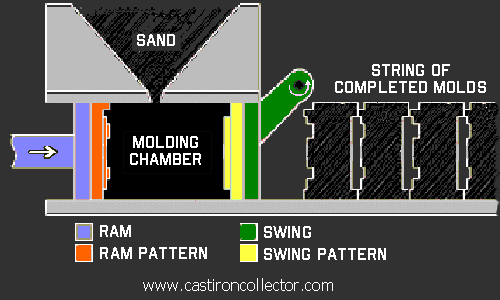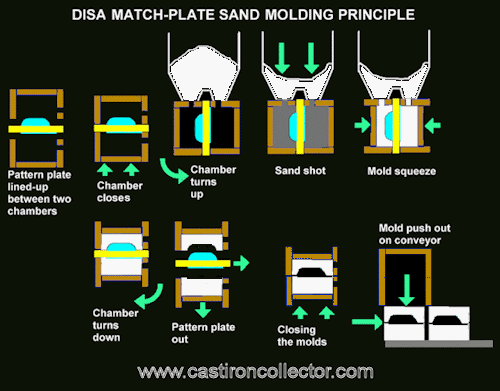Factory Automation
Prior to the early 1960s, cast iron cookware manufacture was largely a manual process. Foundrymen, paid by the piece, created individual sand molds one at a time or in manageable groups capable of being poured from a single ladle of molten iron. Of the tasks involved, mold creation represented some of the most labor-intensive and time consuming.
As early as the 1930s, some manufacturers had developed various levels of automation, mainly to assist in mold creation and handling. Lodge Manufacturing claims to have implemented an automated molding process as early as 1950.
DISA
In 1960, the Danish company Dansk Industri Syndikat A/S (DISA) acquired rights to the patent registered in 1957 by Vagn Aage Jeppesen, a professor at the Danish Technical University, for a device to produce "flaskless molds of sand mixtures with vertical parting lines for the casting of metal parts".
The DISA automated process differed from the manual in a several ways.
Firstly, the orientation of the two halves of the sand mold is vertical rather than horizontal. Although the sand mixture is blown into the molding chamber using compressed air, this also allows gravity to be of assistance in the filling of the chamber.
Secondly, the process was designed such that it did not require the use of flasks, the rigid two-part boxes into which the sand was manually packed and which maintained the alignment of the mold halves after the pattern was removed.
Third, rather than using a hand tool to tamp and compress sand around the pattern, hydraulic rams with patterns affixed to them were now used to compress the sand.
Fourth, the use of separate pattern halves on opposite ends of the molding chamber meant that each compressed block of sand would thereby form both a cope and a drag, each mating not with the other, but instead with the neighboring block in the production line molding string.
In 1962, a half-scale prototype of the sand molding machine, dubbed DISAMATIC, was demonstrated at the International Foundry Trade Fair (GIFA) in Düsseldorf, resulting in the sales of the first two DISAMATICs to European foundries. The first automatic DISAMATIC molding lines were capable of producing 240 sand molds per hour. Modern DISAMATIC lines are able to produce up to 550 molds per hour.

Match Plate
Patented much earlier, in 1910, but not commercially implemented until the 1960s, was the match plate system for automated molding. Under this system, pattern halves are affixed to opposite sides of a plate which is centered in a horizontally-oriented mold chamber. The chamber is then rotated 90° to vertical, sand is injected on either side of the plate and compressed against it by rams. Returned to horizontal, the chamber then separates to allow the release of the match plate, and the mold halves are put together. The sand shot and mold squeeze phases notwithstanding, this process thus produced molds with horizontal parting lines. This method of production is more suited to shorter series runs than the DISAMATIC, as the swapping of match plates is far easier than retooling on the longer run-oriented vertical system.

Considering those qualities which collectors of vintage cast iron cookware hold dear, however, automation spelled the beginning of the end.
No longer feasible were the fine, light castings of late 19th century skillets. Reinforcement of lips and handles no longer sufficed. Entire pan walls and handles had to be made thicker in order to withstand the rigors of automation, the additional iron cost offset by labor savings. Pour spouts shrank in response to breakage the formerly larger protrusions would suffer in post-production machine handling, in some cases being all-but eliminated, with only inside concavities remaining.
Although the final step of polishing cooking surfaces smooth appears to have survived the advent of automation for some period of time, it, too, would soon succumb to the demands for cost reduction that automated molding alone could not stanch.
 A gallery of pre- and post-automation cast iron.
A gallery of pre- and post-automation cast iron.
More About Factory Automation
Modern cast iron manufacture at Lodge 
Official Lodge Cast Iron Foundry Tour Video 








